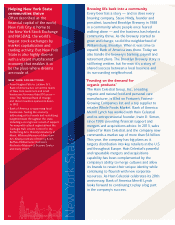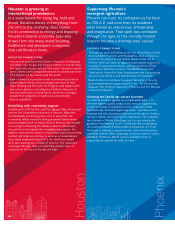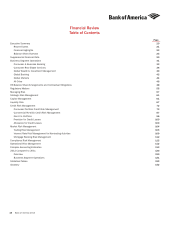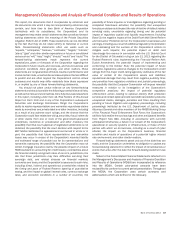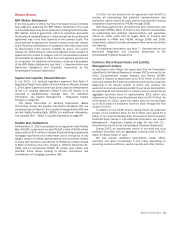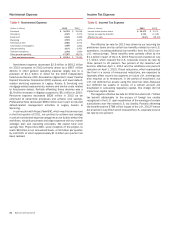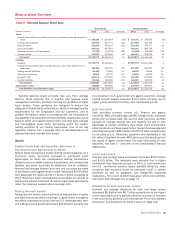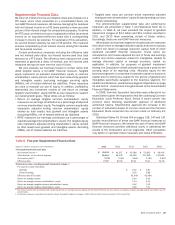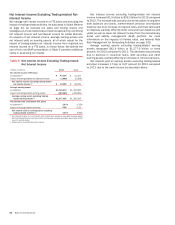Bank of America 2013 Annual Report Download - page 22
Download and view the complete annual report
Please find page 22 of the 2013 Bank of America annual report below. You can navigate through the pages in the report by either clicking on the pages listed below, or by using the keyword search tool below to find specific information within the annual report.20 Bank of America 2013
Executive Summary
Business Overview
The Corporation is a Delaware corporation, a bank holding company
(BHC) and a financial holding company. When used in this report,
“the Corporation” may refer to Bank of America Corporation
individually, Bank of America Corporation and its subsidiaries, or
certain of Bank of America Corporation’s subsidiaries or affiliates.
Our principal executive offices are located in Charlotte, North
Carolina. Through our banking and various nonbanking
subsidiaries throughout the U.S. and in international markets, we
provide a diversified range of banking and nonbanking financial
services and products through five business segments: Consumer
& Business Banking (CBB), Consumer Real Estate Services (CRES),
Global Wealth & Investment Management (GWIM), Global Banking
and Global Markets, with the remaining operations recorded in All
Other. We operate our banking activities primarily under two
national bank charters: Bank of America, National Association
(Bank of America, N.A. or BANA) and FIA Card Services, National
Association (FIA Card Services, N.A. or FIA). On October 1, 2013,
we completed the merger of our Merrill Lynch & Co., Inc. (Merrill
Lynch) subsidiary into Bank of America Corporation. This merger
had no effect on the Merrill Lynch name or brand and is not
expected to have any effect on customers or clients. At
December 31, 2013, the Corporation had approximately $2.1
trillion in assets and approximately 242,000 full-time equivalent
employees.
As of December 31, 2013, we operated in all 50 states, the
District of Columbia and more than 40 countries. Our retail banking
footprint covers approximately 80 percent of the U.S. population
and we serve approximately 50 million consumer and small
business relationships with approximately 5,100 banking centers,
16,300 ATMs, nationwide call centers, and leading online
(www.bankofamerica.com) and mobile banking platforms. We offer
industry-leading support to more than three million small business
owners. We are a global leader in corporate and investment
banking and trading across a broad range of asset classes serving
corporations, governments, institutions and individuals around the
world.
2013 Economic and Business Environment
In the U.S., economic growth continued in 2013, ending the year
in the midst of its fifth consecutive year of recovery. However, the
year ended amid uncertainty as to whether the upward trend in
economic performance would continue into 2014. Employment
gains were generally steady but moderate, and the unemployment
rate fell to 6.7 percent at year end, but with significant contribution
from a declining labor force participation rate. Retail sales grew
at a solid pace through most of 2013, and following extreme
weakness through mid-2013, service spending also displayed a
modest rebound late in the year. Core inflation fell in 2013 to
almost a full percentage point below the Board of Governors of
the Federal Reserve System’s (Federal Reserve) longer-term target
of two percent.
U.S. household net worth increased significantly in 2013.
Home prices rose approximately 12 percent in 2013, but showed
signs of deceleration late in the year, and equity markets surged.
U.S. Treasury yields rose over the course of the year amid
expectations that the Federal Reserve would adjust the pace of
its purchases of agency mortgage-backed securities (MBS) and
long-term U.S. Treasury securities if economic progress was
sustained.
Despite a partial federal government shutdown in October, the
impact on U.S. economic performance was minimal. The Federal
Reserve announced that it would begin to reduce its securities
purchases early in 2014, but would not raise its federal funds rate
target until significantly after the unemployment rate reached its
6.5 percent threshold. By year end, the U.S. Congress agreed on
a two-year budget framework that reduced fiscal uncertainty, and
pending implementation, restored some of the planned federal
sequester spending for 2014.
Internationally, Europe experienced significant economic
improvement in 2013. European financial anxieties eased,
reflected in sustained narrowing of bond spreads, following the
European Central Bank’s 2012 assertion of its role as lender of
last resort. Economic performance also improved, with the long
six-quarter recession in the European Union ending in the second
quarter of 2013, followed by modest growth and varied
performance in the second half of the year.
Monetary policies in Japan combined with the sharp
depreciation of the yen led to moderate economic expansion in
2013, but economic growth diminished in the second half of 2013.
In Japan, inflation rose gradually during the year, exceeding one
percent annualized by year end. However, doubts remained about
the sustainability of economic improvement in Japan in the
absence of clear plans for long-run economic reform. As China’s
government focused on issues beyond simply maximizing
economic growth, China’s gross domestic product growth in 2013
decelerated.
Additionally, growth rates in a number of emerging nations have
decreased, while select countries are also dealing with greater
social and political unrest and capital markets volatility. Following
the announcement of the Federal Reserve’s intent to reduce
securities purchases in mid-2013, investors increased
withdrawals of capital from certain emerging market countries,
impacting interest rates, foreign exchange rates and credit
spreads. These trends intensified as the Federal Reserve initiated
its securities purchases tapering actions in January 2014, and
investors became more concerned about the implications of a
slowing Chinese economy on its key trading partners. For more
information on our international exposure, see Non-U.S. Portfolio
on page 96.




